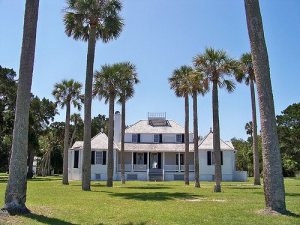The oldest surviving plantation house in Florida was built on Fort George Island in 1797-8 by Irish-American expatriate Don Juan McQueen. Fort George Island is a sea island, located at the mouth of the St. John’s River, northeast of Jacksonville.
John "Lightning" McQueen (1751–1807) was a daring hero of the American Revolution, was a friend and confidante of George Washington and the Marquis de Lafayette, and was one of the country’s largest land-owners. After the Revolution, McQueen speculated heavily on timber land in Georgia and South Carolina, went bankrupt, and was facing arrest and debtors prison when, in 1793, he fled to Spanish East Florida, leaving his wife and children in Georgia.
In St. Augustine, the charismatic Irish-American renounced his American citizenship, became a loyal Spanish subject, a devout Catholic and the trusted advisor and confidante of the Spanish Governor, and he was thereafter known as “Don Juan McQueen”. In East Florida, McQueen’s fortunes improved quickly, and he became one of the largest landowners in East Florida, Captain of the East Florida Militia, Commander of the Banks of the St. John’s and St. Mary’s Rivers and a judge. He enjoyed the social life of St. Augustine, and his Irish friends there, including Father Michael "Miguel" O’Reilly, the worldly parish priest, and Colonel Charles "Carlos" Howard, the commander of Spanish military forces in East Florida, but he rarely saw his family, who preferred to remain in America.
The main plantation house has a unique architectural style, with a large center room, surrounded by one-story pavilions, one at each of the four corners, and wide verandas, which allowed air to circulate throughout the house to keep it cooler in the summer. Each corner pavilion was a sleeping room, with complete cross-ventilation and access to a veranda. The second story of the house has two large rooms.
On the roof is an observation deck. The house faces the Fort George Inlet. A brick walkway joined the back porch to a wharf on the inlet. A covered walkway connects to a separate building that later housed the kitchen and storerooms. It was customary to separate the kitchen from the main house, in case of fire from the wood-burning stove, oven and fireplace. The sequence of construction of the plantation’s buildings is not certain. McQueen described his Fort George Island house as "small" and "comfortable", so it is likely that the "kitchen" building shown below was the house built by McQueen, and that the larger plantation house was built by the subsequent owners.
The house protected McQueen and neighbors during an attack by Creek Indians in 1802. He wrote at the time that 26 people took refuge there. By East Florida standards, McQueen was considered a very wealthy man, but he struggled to repay his debts in America, because it was difficult to generate cash income in sparsely populated East Florida; so in 1804, he was forced to sell the Fort George Island plantation to an American friend.
During the same period, he built a grand mansion on his vast "Los Molinos de McQueen" estate on the south side of the St. John’s River, hoping to entice his family to join him in East Florida. McQueen’s many business ventures eventually began to prosper, but he died before resolving his debts in America, or seeing his beloved wife Anne again. Don Juan McQueen died of typhoid fever in 1807 and is buried in the Tolomato Cemetery at St. Augustine. If you would like to read more about the fascinating life of Don Juan McQueen, there is a wonderful historical novel of the same title written by Eugenia Price.
Don Juan McQueen’s Fort George Island plantation became known as "Kingsley Plantation", the name which it still carries. The property is listed on the National Register of Historic Places and is operated as a historic site and museum by the National Parks Service. Kingsley Plantation is open seven days a week, from 9:00 a.m. to 5:00 p.m., except on Thanksgiving Day, Christmas Day, and New Years Day. Admission is free. A visitor center and bookstore are located in a 1920’s building adjacent to the plantation buildings. The plantation house is currently closed to the public while undergoing restoration.
National Parks Service – Kingsley Plantation Website







He also had property and a house on Amelia Island Fl. The history of this man is fabulous. The State of Fl and the National park service does not tell all the history of the Island. The longest surviving Spanish Mission was on the Island, it is marked, but on the wrong side of the Island. James Oglethorpe had a fort on the island. Pottery on the Island goes back to the Orange period, that’s 5000 years of occupation by humans.
The plantation was one of the fine, challenging golf courses in the area until it was closed in the 1990’s. The main house was the club house and Pro Shop. It is a little out of the way for most since there are quite a number of golf courses in the area. We always felt it was worth the drive.
Mr. Baer you are a tad confused. The above property in the article has never been a golf club facility. The place you are referring to is another property located elsewhere on the island. Please visit Kingsley Plantation and take the historic tour.
This so nice we go to the plantation a lot it is beautiful